A look at Windows 8 Tablets running on TI, Qualcomm, Nvidia, AMD and Intel silicon
by Brian Klug on September 14, 2011 9:00 PM ESTThis afternoon (and yesterday) we had a chance to meet with a number of SoC vendors who have partnered with Microsoft for Windows 8. Each of them has their own individual reference tablet running Windows 8, and today we had a chance to survey the landscape and get photos of all the tablets. We started with ARM, then looked at x86 based tablets. Of course, the real goal with Windows 8 is to abstract as much of the difference between these two platforms away.
Unfortunately, all of the ARM vendors were required to keep their tablets under glass and out of the way of physical contact per Microsoft instruction. Microsoft isn't ready to show off the ARM version of Windows 8 for a variety of reasons at this point (at least without a Microsoft rep. present), but we still got a chance to at least take a look at what there is now. Microsoft is encouraging tablet makers to target either a 10.1" or 11.6" form factor with 1366x768 resolution (ed: Metro will require 1024x768 as a minimum, so 1280x720 displays don't meet Microsoft's requirements).
Texas Instruments
First up is TI, whose development platform was demoed playing back the 1080p30 H.264 baseline video shown in the keynote fluidly in windows media player with a split-screen view. One tablet displayed the start menu, another displayed two split screen games. TI's development platform as shown right now is running on OMAP 4430, which again consists of two ARM Cortex A9s at 1.0 GHz and PowerVR SGX 540 graphics. Windows 8 won't launch on OMAP 4430, however, instead it'll launch on the more powerful OMAP 4470 platform with PowerVR SGX544 graphics and a 2D display compositor. The reason is partly due to SGX544 having full Direct3D 9.3 compliance, partly because it's an all around faster platform. I'm told that right now there's some Direct3D emulation going on as well for all the SoCs that don't support Direct3D 9.3.
I also recorded a short video showing the TI Windows 8 tablet in action.
Qualcomm
My next stop was Qualcomm, whose current development tablet runs on an MSM8660 SoC, which consists of two scorpion cores and Adreno 220 graphics. Qualcomm took the tablet out of the glass box for us and showed a quick demonstration of the start menu scrolling back and forth, and the IE10 mobile view working and scrolling around.
Unfortunately we weren't allowed to shoot video of the tablet while that demo was running, but we did grab some photos of the tablet without the glass box. Performance on the start menu looked to be above 30fps the whole time but not buttery smooth like the x86 tablets we've seen so far.
Just like TI, Qualcomm won't go to market with the SoC they're demonstrating Windows 8 working on today, instead they'll use the more powerful dual core Krait MSM8960 at first and quad core Krait APQ8064 later on. Dual core krait SoCs (eg 8960, 8270, 8260A) come with Adreno 225, quad core krait (APQ8064 and others) come with Adreno 320, both of which are Direct3D 9.3.
NVIDIA
We've seen NVIDIA's Kal-El quad-core A9 based tablet a few times now, and found it out on the floor, also behind glass. Unlike the other vendors, NVIDIA hasn't said anything about going to market for Windows 8 with anything but Kal-El, and I don't see any reason why they should either.
The Kal-El development tablet was seated in a nice looking dock with what looks like one USB 3.0 port and a full size HDMI port.
AMD
Switching over to the x86 camp, we have AMD, who showed us two tablets running on Brazos - the Acer Iconia Tab W500 and MSI WindPad 110W, which use a C-50 and Z-01 APU, respectively. Displays on these are 1280x800 and support capacitive touch just like you'd expect for Windows 8.
Both the MSI WindPad and Iconia Tab felt snappy and responsive running the same Windows 8 Developer Preview build that we've used on the Samsung developer hardware. Subjectively, the WindPad's capacitive panel was more responsive and less prone to errant touch recognition than the Iconia, though both were more than useable with Windows 8.
Intel
Last but not least is Intel's own development tablet, which is running an unnamed 32nm SoC. Intel was suspiciously silent about which particular SoC was inside this device, and you'll notice that it too is locked down in a plastic box, lumping it squarely in the next-gen SoC category for Microsoft.
It's possible this is Medfield, it's also possible this is some 2nd gen 32nm Atom SoC. Hopefully we'll find out more as Windows 8 starts getting closer to launch.


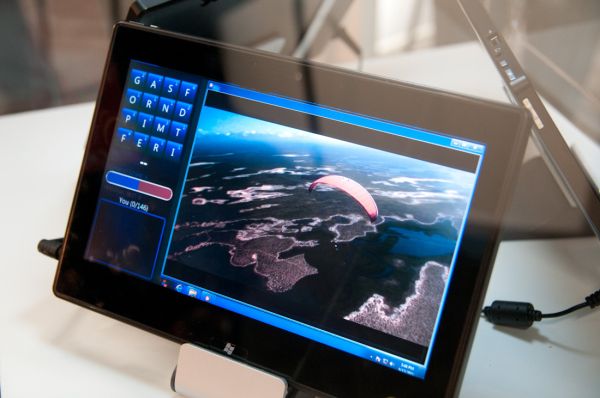
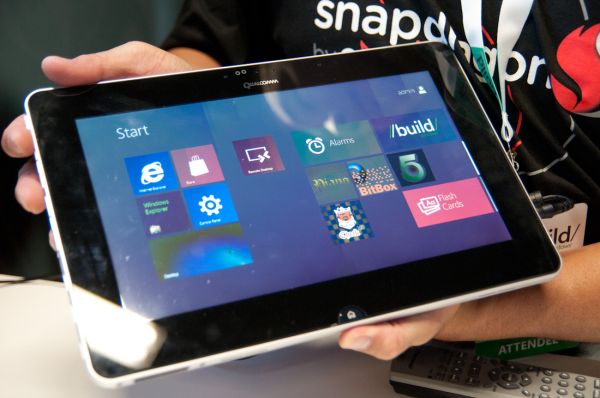
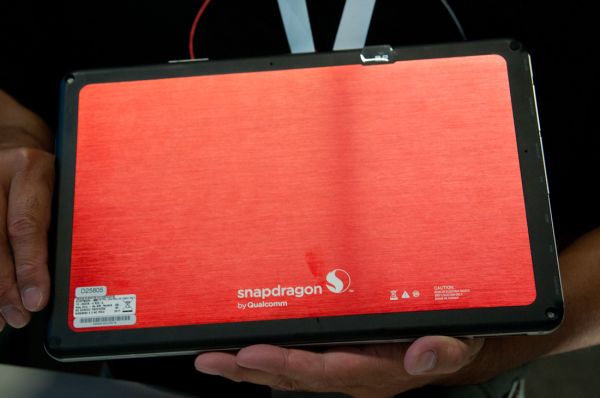
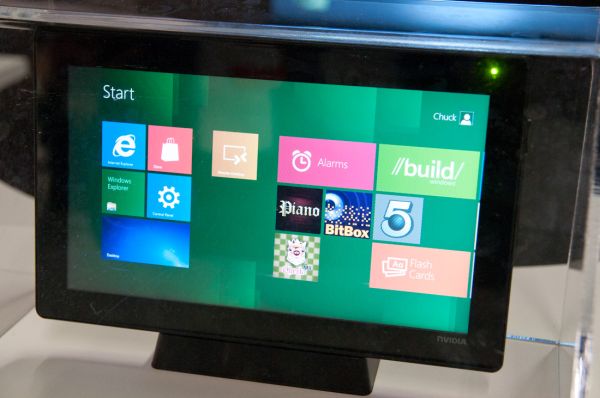
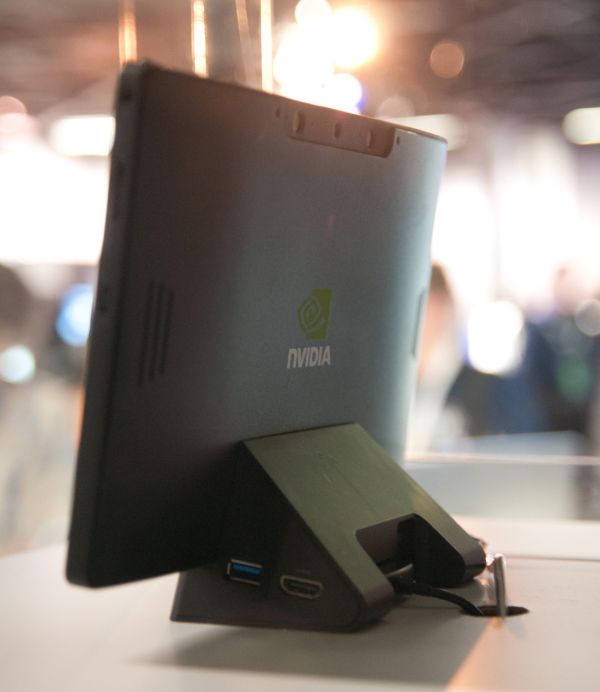
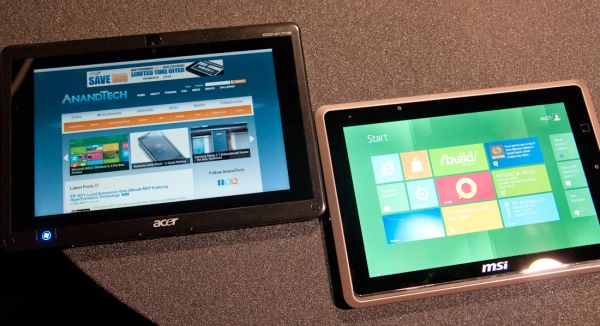
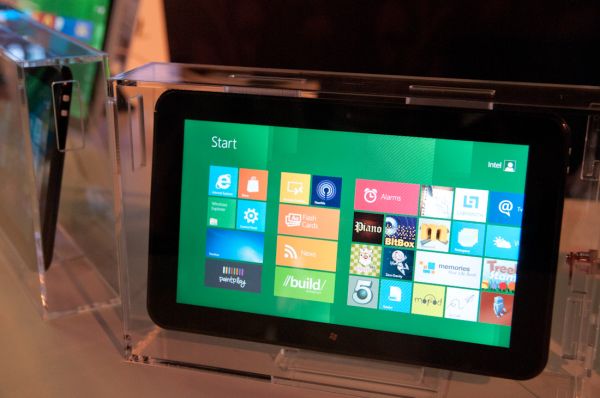














92 Comments
View All Comments
extremepcs - Thursday, September 15, 2011 - link
Oops, I just noticed the ribbon interface goes away when you disable Metro. I had not opened explorer since I disabled it.Penti - Saturday, September 17, 2011 - link
No not necessarily, you can have it enabled the same time as you have disabled Metro, just check around for the tools/configs. Not a problem.RW - Thursday, September 15, 2011 - link
But if Apple continues and succeeds in blocking any tablet maker from selling it's tablets around the world then you will not see any Windows 8 tablet, nor Intel x86 tablet, nor Android tablet so anything that you see here today will be banned in an all Apple no competition world.Lord Moldy butt - Thursday, September 15, 2011 - link
I highly doubt Apple will mess with MS. They may be competitors, but they are not stupid.thebeastie - Friday, September 16, 2011 - link
If you want a x86 Windows 8 tablet that can be PC desktop like you will have to accept you will ALWAYS be minus -%25 CPU performance just for the sake of the AntiVirus software YOU WILL ABSOLUTELY need. It will always be a crappier experience then the Androd/iPad alternatives.thebeastie - Friday, September 16, 2011 - link
And -%25 on battery at least. Antivirus tools are very power intensive.thebeastie - Friday, September 16, 2011 - link
Sorry can't edit my posts, but seriously x86 tablets are really just Intels way of trying to keep a strangle hold of its CPU market and is going to be the absolute sucker technology choice for the narrow minded tech heads out there.Zan Lynx - Friday, September 16, 2011 - link
If you use a locked down App Store with no other way to install software on the tablet, then you only need to run AV on the App Store itself.There is the occasional remote security exploit but for the most part it's when you allow people to install whatever they feel like that you get virus problems.
soliozuz - Friday, September 16, 2011 - link
I really like the dock they have set up for it and it's an impressive move, especially with USB 3.0 but let's see what it has to offer. I don't think the iTampon can survive what's coming.jwcalla - Friday, September 16, 2011 - link
Microsoft has such a huge presence and vendor influence that any time they step into a certain segment, the competitors should be worried. While I personally don't understand the fascination with a Wintel tablet or phone, I can tell that quite a few people are desperate for one.And in my experience, for every iFanboy I run across, there are easily 10 Windows fanboys.
Microsoft is almost always way behind the curve with just about every one of their products, but they have such a large "mental lock-in" with consumers and businesses so they really have no need to be anything better than mediocre. They don't have to draw anybody in... they just have to keep people from leaving the stables.